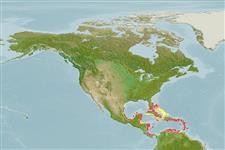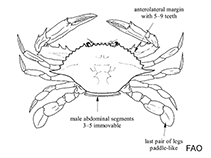Callinectes rathbunae Contreras, 1930
Sharptooth swimcrab| Native range | All suitable habitat | Point map | Year 2050 |

|
| This map was computer-generated and has not yet been reviewed. |
| Callinectes rathbunae AquaMaps Data sources: GBIF OBIS |
Upload your photos
Google image | No image available for this species;
drawing shows typical species in Portunidae.
Google image | No image available for this species;
drawing shows typical species in Portunidae.
Classification / Names Common names | Synonyms | CoL | ITIS | WoRMS
Malacostraca | Decapoda | Portunidae
Environment: milieu / climate zone / depth range / distribution range Ecology
Benthopelagic; brackish; depth range 0 - 3 m (Ref. 97531). Tropical
Distribution Countries | FAO areas | Ecosystems | Occurrences | Introductions
Western Central Atlantic: Gulf of Mexico.
Length at first maturity / Size / Weight / Age
Maturity: Lm ? range ? - ? cm Max length : 14.0 cm WD male/unsexed; (Ref. 367); 15 cm WD (female)
Short description Morphology
Carapace twice as broad as long; 9 teeth on moderately arched anterolateral margin (including outer orbital tooth and strong lateral spine) acuminate with edges variably granulate; front (excluding inner orbital angles) bearing 4 acuminate teeth, inner pair narrower than outer. Marginal slopes of convex dorsal surface smooth and glistening (when wet), central part lightly and evenly granulate, transverse lines prominent. Pincers with sharp granulate ridges, fingers of major hand heavily toothed but not gaping; fifth leg flattened in form of paddles. Male with T-shaped abdomen reaching nearly to juncture between thoracic sternites 3 and 4; slender first pleopods sinuously curved, overlapping in proximal half, diverging distally with dorsolateral narrow band of large and small sharp retrogressive spinules. Color: green and blue with tints of red, orange, and purple; underparts white.
Benthopelagic. Euryhaline (Ref. 97531). Inhabits estuarine waters of ditches, lagoons, and river mouths. Feeds on a variety of materials including mollusks, other bottom invertebrates, and some fishes, carrion and detritus (Ref. 367).
Life cycle and mating behavior Maturity | Reproduction | Spawning | Eggs | Fecundity | Larvae
Members of the order Decapoda are mostly gonochoric. Mating behavior: Precopulatory courtship ritual is common (through olfactory and tactile cues); usually indirect sperm transfer.
Main reference
References | Coordinator | Collaborators
Tavares, M. 2003. (Ref. 367)
IUCN Red List Status (Ref. 130435)
CITES status (Ref. 108899)
Not Evaluated
CMS (Ref. 116361)
Not Evaluated
Threat to humans
Human uses
Fisheries: minor commercial
| FishSource |
Tools
More information
Internet sources
BHL | BOLD Systems | CISTI | DiscoverLife | FAO(Publication : search) | Fishipedia | GenBank (genome, nucleotide) | GloBI | Gomexsi | Google Books | Google Scholar | Google | PubMed | Tree of Life | Wikipedia (Go, Search) | Zoological Record



